


MANDATORY DISCLAIMER! Everything I carry is legal where I live, it might not be legal where you live, and it will certainly delay any flight you try and take it on. Some of it is toxic, some of it is dangerous in the wrong hands some unsafe in the right ones, some of it is just simply ill advised. Carry with caution.
With the exceptions of pants failures, popular music and beagles, nothing annoys me more than not having the right tool when I know for a fact that I have exactly what I need in my moderately well stocked laboratory. To combat this, I've made an attempt to carry everything that I am likely to need on or with me. Over the years I've gone from having a multitool, a loaded pair of cargo pants, a small kitbag I kept in my car, to finally filling all the extra space in my laptop case with tools, gear and materials. My loadout has gone through a number of revisions over the years, depending on what I use and what I don't use. Some things are startlingly useful, some things are needed so rarely that it's worth considering swapping for something more useful. This guide intends to give a quick overview of what I carry, why it's useful and give a brief insight into the mind of a geek who takes "Be Prepared" as a moral imperative.
Firstly: a note on multitools. The multitool is the single most useful thing I carry. It's not good for all circumstances, but unlike the laptop case, I can keep it on my belt or in my pocket and always have it at hand. I personally carry a Gerber 600. From experience I can attest that it's not the best I have owned (that honor goes to the Leatherman wave), but it's a very close second and the one handed "flick-click" opening gives it a certain amount of charm that the wave lacks. Few things in life give me as much joy as the look on the face of bystanders when I snap my multitool into the ready position. Even if I had the opportunity to trade for a Wave, I'd stick with my Gerber. I know of the Gerber Freehand, that seems to combine the external knife blade of the Wave with Gerber's unmatched tool steel and flick opening. I've never handled one and as such can't make a quality judgment. The $72 dollar price tag ensures that I won't get one for a bit.
Regardless of which one you pick, the multitool is the single most useful thing for any geek or geekette. They make a decent pair of piers, a usable knife and a crappy screwdriver, but they have all that and usually more in something you can have in your pocket at all times. The only time I am without my multitool is when I'm naked, flying, or both. If I was stuck on a desert island, my well used Gerber may not be the best thing to take with me, but it would be the most comforting.
The laptop case I have was picked up as a bit of vendor swag at a texas National Instruments convention. It has a few features that makes it ideal for my uses. It is equipped with both a shoulder sling and backpack straps, it's thin enough to be easily held in the lap and the pocket for the laptop is well padded. It holds up to 12 inch laptops, but currently carries my 10 inch EEPC. The best feature is the non computing compartments. There's the main laptop flap which also has a couple of small pockets for things like power supplies and pens, 3 independent zippered pouches and a flap covered pocket for larger parts, plus an elastic and mesh pocket for drinks. I've never seen another bag exactly like it, but thankfully this one has been holding up well for close to five years.
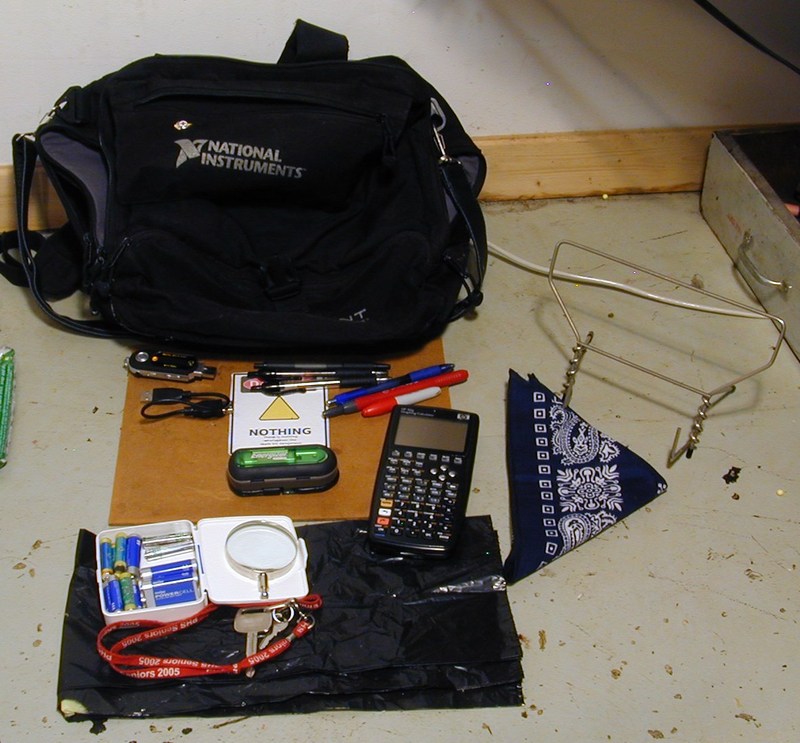
This pocket carries my laptop as well as tech and office supplies. The digital camera (not shown) is a Nikon CoolPix 950, not the newest camera by a decade, but I know this camera well. It doesn't have the most pixels per shot, but it's familiar enough that I get the pictures I want, when I want them. The MP3 player is an old one that I swapped out from regular use for one with an inbuilt chargeable battery. I keep it for backup, in-field signal generation and as a USB thumb drive. The board that everything is resting on is a hunk of 1/16 inch stock that is useful if I need a hard surface to write or work on. It doubles as a base for soldering if I don't want to get molten lead on the tablecloth. Remember! Be polite when you solder in other peoples houses. It also has a Waring: Nothing Dangerous label on it, for those times I'm accused of building bombs in the student center.
The calculator is the HP 50G, the best graphing calculator yet invented. RPN, good textbook notation and the single best hand-held computer algebra system in existence. I keep a small box of batteries in AA, AAA and a 9 volt sizes. Both my camera and calculator normally run off of rechargeable, so I picked up a USB battery charger for mobile re-jucifications. The magnifying glass can be mounted on the 3rd hand altoid tin (below), useful for obvious reasons as well as igniting things with sun power. The bookstand is handy for taking notes out of text books on limited table space. It can also be used to coil thin rope. Loop the rope around the metal bars, then fold the holder for easy removal of the coiled rope. The trash bag is an item with many uses. It most often gets used for an impromptu rain jacket, but has seen service in the past to cover broken windows, hold an oxy-acetylene mix to form a rather loud balloon and even (on occasion) store trash. If there's one thing that should be in everyone's laptop case, this is it.
The black triangle is a bandanna. A Bandanna has a multitude of uses, from wrapping around one's head to keep the sweat out of one's eyes, to cleaning up messes, to an impromptu dust mask to a makeshift sling (when combined with rope). I like to think of it as my own mini towel, and as any fan of douglass adams knows, it is always worthwhile to know where one's towel is:
"A towel, it says, is about the most massively useful thing an interstellar hitchhiker can have. Partly it has great practical value - you can wrap it around you for warmth as you bound across the cold moons of Jaglan Beta; you can lie on it on the brilliant marble-sanded beaches of Santraginus V, inhaling the heady sea vapours; you can sleep under it beneath the stars which shine so redly on the desert world of Kakrafoon; use it to sail a mini raft down the slow heavy river Moth; wet it for use in hand-to- hand-combat; wrap it round your head to ward off noxious fumes or to avoid the gaze of the Ravenous Bugblatter Beast of Traal (a mindboggingly stupid animal, it assumes that if you can't see it, it can't see you - daft as a bush, but very ravenous); you can wave your towel in emergencies as a distress signal, and of course dry yourself off with it if it still seems to be clean enough.
Smallest but most likely to save my day is a spare set of keys. Some people out there never forget or lose their keys. I am not one of them. I have one for my car, one for my house and one for the padlock I use for my bike and gym locker. The final one was added after I locked my keys and clothing in the changing room locker. I kept my laptop case locked in the day locker outside, so I had access to my lockpick but it took me close to a half hour to crack the lock. Interesting fact: a naked man spending 20 minutes picking a lock gets no odd looks in the gym I go to.
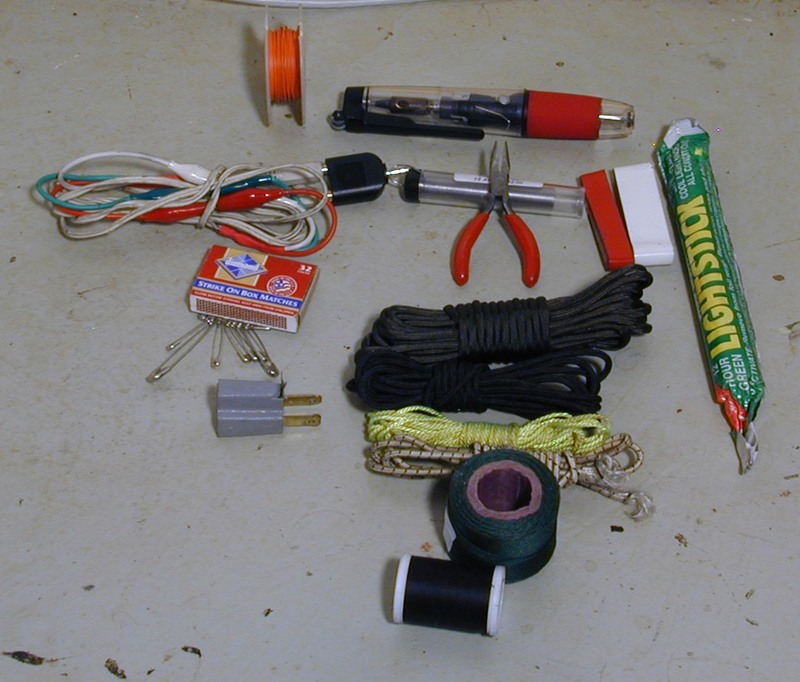
The front flap pouch holds electronics repair gear. The soldering iron is a cheap butane iron picked up from radio shack. it gets far too hot for serious work, but for fixing one or two solder joints it's more than adequate. I've considered the cold heat style battery based iron, but from everything I've heard, they're too cold for serious work and can cause destructive high voltage spikes. Gas powered irons have the added benefit of a swappable tip for torch work. Not often useful, but additional functionality in the same sized package is key to an efficient toolkit. Weller has a few different models, ranging from reasonable to worth more than my first car. The Weller iron would give you better heat and more reliability. Some day, I may spoil myself and pick one up. The solder I keep with it is the standard 60/40 tin/lead solder with a rosen core in a tube for convenience. Lead free might be in my future, but as a rule if I need to use the soldering tools in this kit, I'm in a situation where the added headache of ROHS solder is not something that I need. The needlenose pliers back up the pair on my multitool. The ones on my multitool usually suffice, but this pair has a finer tip, and an off hand pair is often nice to have.
The audio cable has been broken out into the 3 major strands (left, right, ground) with alligator clips. This has 4 uses: Standard dual ended audio plug (used regularly in classes for presentation, as they never give you the cables), an audio extension cable (plug the jack into the splitter and it gives you several extra feet) and a set of alligator clipped leads. The clips can be used for general purpose work if both jacks are left in the splitter, or they can be used to adapt the jacks to different sources. With a bit of improvisation they can be used with RCA jacks. Most 1/4 inch jacks have unscrew able tops, so the alligator clips can hook up to the metal tabs and the plugs can be used for 1/4 inch to 3.5mm adaption.
The glostick is a fallback to when I lived in Podunk, Michigan, where annual multi-day power outages were tradition and having a convenient light to guide you to the bathroom is something nice to have. It's been used in impromptu raves or on road trips for reading books on dark drives. Any of the flashlights I carry would work well enough, but glowsticks are easier to hold and won't distract the driver. The matches are as a backup to my zippo. A lighter might be more reliable and provide more uses, but matches have that sulfur smell I love.
This flap also holds Cordage. Rope is another item who's use is limited only by one's imagination. The good ole 550 paracord has served as impromptu belt, shoelace, door latch, ascension device, enhancing the grip of handles, laptop strap replacement, makeshift clothes line, cargo tie down, and probably other things that I can't remember at the moment. A 20 foot span of 550 paracord is the second thing I recommend everyone carry in their laptop bag. The carabiner backs up a second, higher quality one I keep on my keychain.
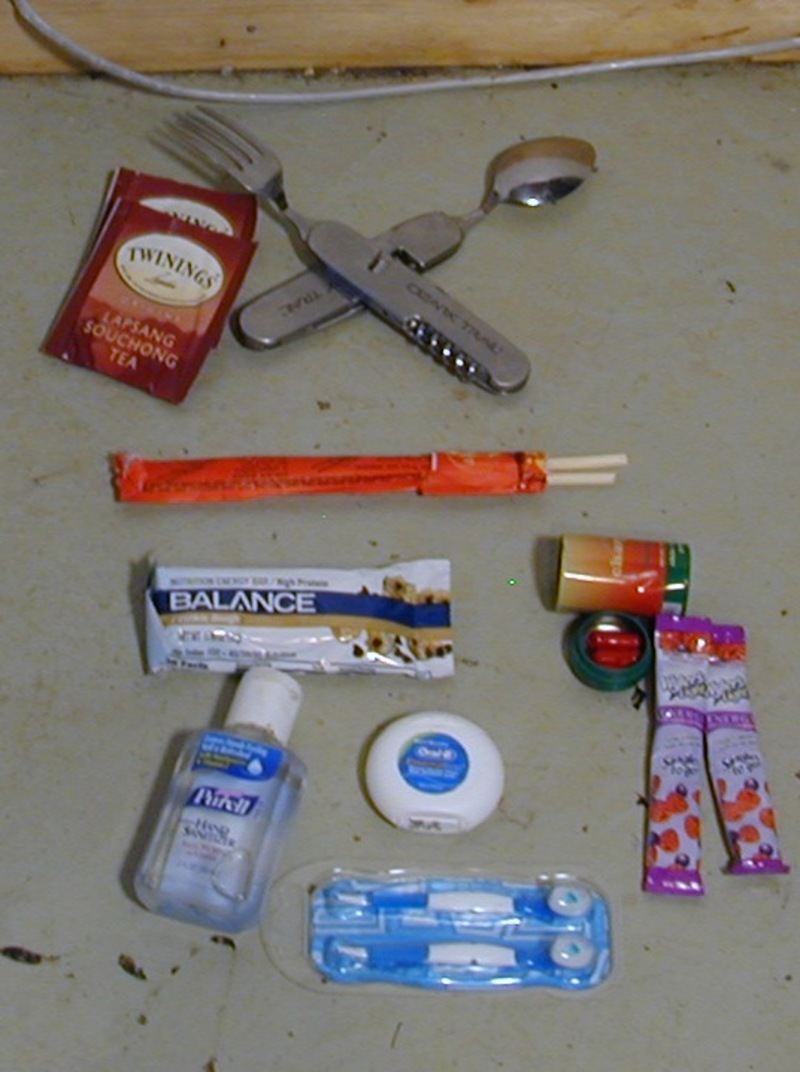
The pocket on the side carries food and drink related accessories. Field repair can be hungry work, so this is important. The Hobotool (pocket knife with built-in fork and spoon) I received as a Christmas present and combines a fork, knife, spoon, can opener and corkscrew in a single (albiet bulky) package. It is kind of like a culinary multitool, and is rather surprisingly one of the most used things in my case. The chopsticks are for those times that I'm hanging around with my anime freak friends and want to show off. They double as repair/rework material. I can brace and reinforce things using them in conjunction with zipties or epoxy.
As for actual food and drink, I keep a protein bar (whichever one is on sale, when I eat it I care more about the calories than the taste), tea, single drink mixes (caffeinated, naturally) and caffeine pills for those occasions that I really need the kick in the ass. The tea is Lapsing Suchong which tastes like a good dark tea mixed with burnt oak. It is an acquired taste, but my favorite out of all the tea in China.
This pocket also holds the hygiene products of the hand and oral variety. The hand sanitizer is self explanatory, and occasionally sees double duty for sterilizing cuts or cleaning off the Hobotool. I carry a roll of floss, and a pack of single use micro toothbrushes for times when they are needed. Floss has the obvious use for teeth cleaning and occasionally comes in handy as easily snapped twine.
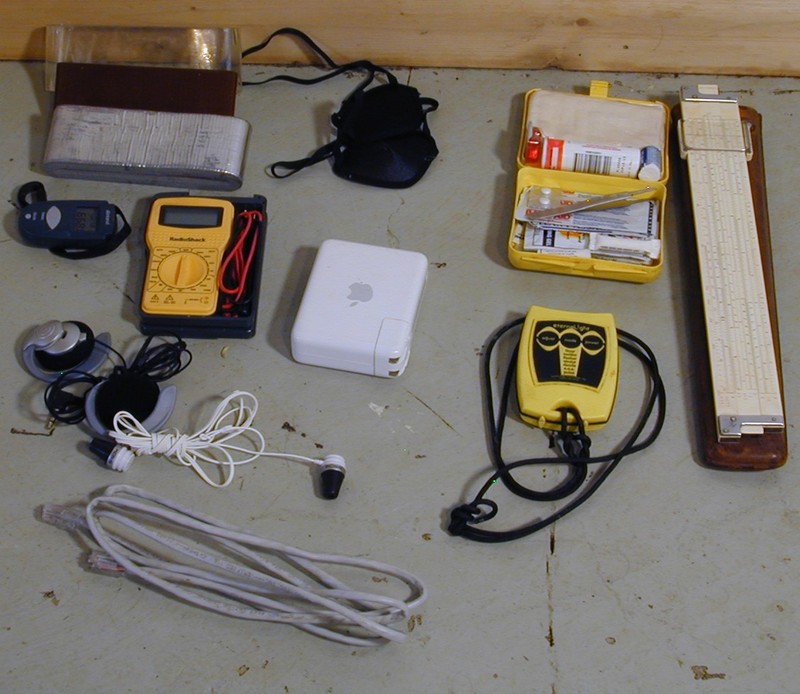
The flap covers a storage area where I keep some of the bigger tools. Three types of tape, silver duct tape for flashy works, stronger, brown duct tape for when I need it to stick and clear packing tape for transparent adhesion needs. The cardboard cores of the rolls were stripped out and the tape clamped flattened in a vise. This gives one of the most useful things a man can have in a small package. Admittedly, two separate forms of duct tape is somewhat excessive, but I have a certain fondness for shiny chrome duct tape, and while I like to use it, I don't like to waste it, hence the backup.
Anyone who's ever watched the Red Green show will not be surprised to see that it's my 3rd essential thing to keep in your laptop case. If you don't want to use my tape squishing methods, there's off-the-shelf options that can be tossed anywhere for when you need it.
The IR temperature sensor's range is poor (only up to 121°C/250°F), but it has built in stopwatch functionality and is more compact than the nicer model I own. It's most common use is monitoring the temperature of water for tea or reading body temperature via ear. The multimeter is a radioshack clearance special. Not the best by a long shot, but it's rare that I need a good meter without needing something else I can't carry with me. I have 2 sets of backup headphones, one's my standard over the ear kind, the other has built in earplugs for working in noisy environments. The flashlight is the EternaLight Marine 3m, it's waterproof, features an auto off for when it's accidentally activated, floats thanks to lightweight lithium batteries, lasts me years of regular use without having to change said batteries, and includes rarely useful but often fun features like strobe, Cylon blink and SOS pulse. The lanyard (which is 550 cord) is looped around the strap that holds the flap closed, so if I need the light all I have to do is grab the cord, snap the flap open and pull and it is in my hand.
The network cable is 5 feet/1.5 meters long, which I've found is the minimum necessary for most uses. I crimped up several at that length at once as spares and if I need additional wire for repairs, I can scavenge it from the cable. 100BaseT only uses wires 1,2,3 and 6, so the cable is still usable with half the wires scavenged for electronics repair. It rarely connects to my computer, as I generally prefer to hook it up to my Apple Airport Express so I can take advantage of the EEEpc's mobility.
My first aid kit, with the exception of the instruction card, is all stuff that I've collected over the years. The basic first aid kit you can buy will have band-aids, antiseptic wipes and possibly a full size bandage. Enough for cuts and scrapes, but not for anything more. You're not going to fit an entire surgical suite in something that can fit in a pocket, but simple things like eye drops can, if not save someones life, then certainly save someone's day.
The kit contains the standard Bandaids and alcohol wipes, a single large sterile bandage, antiseptic and burn ointment, as well as headache medicine1, antacids, anti-diarrheal pills, antihistamines, cough medicine and eye drops. I've recently added a small styptic pen for tiny nicks. The most useful nonstandard item is the tweezers. Splinters happen anywhere, and having a good quality pair of tweezers (miles better than the stuff you'll find in a swiss army knife or eyelash kit) is invaluable to extraction. Most of the kit's contents were added over the years as I or people around me needed them. I'd pick up a full box of (for example) cough medicine, break off 2 capsules, and toss them in the kit. The kit still closes (if carefully arraigned), so I will add more as needs come in.
The pair of eye patches are there because the drug store didn't have a sleep mask in stock when I needed one. They do have certain advantages over a standard sleep mask. They can be combined with the bandanna to make an impromptu pirate costume. I've also found that if you are wearing a pair of eye patches and sleeping in a public place, people are less likely to wake you up than if you just close your eyes or use a standard mask.
Rounding out the tools is the slide rule. The model I carry is a K&E 4081-3 12 inch log-log duplex decatrig in the original hard leather case. Most often gets used as a straight edge for drafting, but sometimes I can't resist calculating as they did before transistors. Heinlein once said "Anyone who can't use a slide rule is a cultural illiterate and should not be allowed to vote", and who am I to argue with a science fiction grand master?
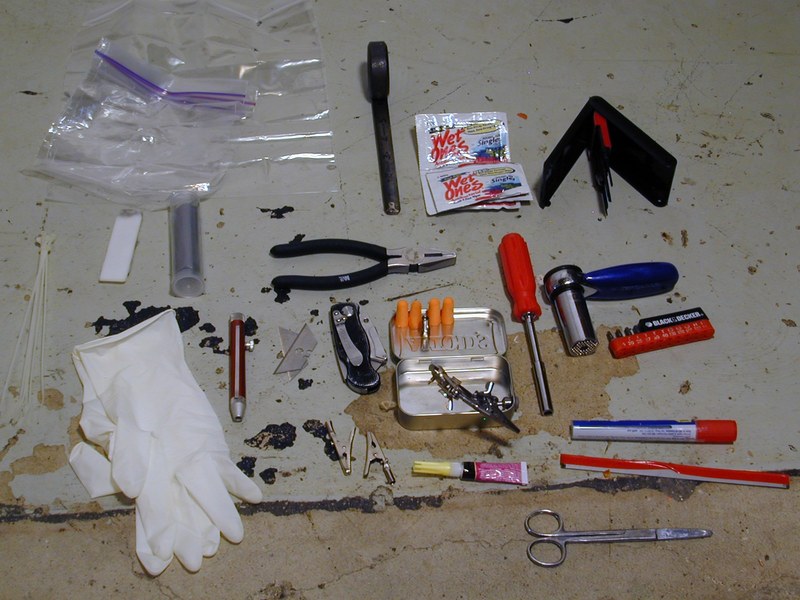
The bottom pouch carries general purpose tools and fabrication gear, as well as some leftovers that didn't really fit anywhere else. First and foremost is the scissors, a pair of surgical scissors liberated from the U of M hospital that have been in my toolkit since highschool. I've had that specific tool with me for longer than anything else in my pack, and it has earned it's dollar price tag at least once a year since I started carrying it. A good pair of scissors is the 4th thing I suggest everyone carry with them. Some (me included) prefer knives for most cutting, but scissors are safer, less threatening and more familiar to many.
Speaking of knives, the folding utility knife is the finest utility knife I have ever owned. None of this "sharpening" nonsense. When the blade gets dull, just flip it over for the other end or swap it out. It doesn't need to be babied, as chipped blades can be replaced. There's a number of models like this out there, mostly only differing in the way the blade snaps in. My model has a metal bracket that closes over the blade enclosure (closeup) which is hard to change, but in my experience provides the best blade retention.
The altoids tin has the 3-rd hand parts from the 5 minute mods page and also holds spare razor blades for the utility knife, latex gloves, superglue, torch attachment for the soldering iron and ear plugs. The alligator clips are stored in the handle of the screwdriver, but are mentioned here as they are generally used with the 3rd hand to hold additional parts in place. They also work as paper clips. I carry redundant earplugs because they are rather small and something that I often need to distribute. I originally carried hypoallergenic disposable vinyl gloves, but it turns out they rapidly dissolve when dipped in industrial solvents (something that comes up often in my life), so I replaced them with latex gloves.
Wet wipes are stored in this pocket, and are generally used for cleaning monitors and those times when the toilet roll is empty. I also have sandwich bags, both the standard and 1 quart size. Surprisingly, the sandwich bags are often used for their intended purpose, as I like to smuggle sandwiches out of the cafeteria for a later snack or to offer to one of the many hobos that wander the campus of Wayne State University. A rarely useful but sometimes essential part of my kit is the lockpick. It's not a particularly nice one, and I'm not good at picking locks (fine motor control is not among my skills), but every now and then, it is enough. Rounding out the random tools is a tape measure. The oldest tool in my kit by a long shot, this imperial-only tape measure originally belonged to my grandfather. It's somewhat unique in that it doesn't have the auto withdraw feature that you find in every modern tape measure, and has to be manually pushed back in. I find this makes measurements easier, but your mileage may vary.
Duct tape is the de-facto standard for holding things together, but for an experienced guerrilla repairman, it is not always enough. For small parts that were meant to go together, the superglue I carry in the altoids tin is sufficient, but sometimes you need to put things together that cannot easily be joined, that's when I get out the big guns.
I used to carry a tube of JB quick epoxy for situations where duct tape is insufficient. It has recently been replaced with JB Stick weld, which is slightly bulkier but much handier for field repairs. It's mixed by slicing off a length and kneading it together, so you don't need a special surface and sacrificial mixing stick. Once mixed, it has the consistency of modeling clay and sets in 3 minutes, so it can be used quickly with poorly supported parts.
For less permanent fixes, a daub of ShapeLock is included. For those of you that have never heard of ShapeLock, it's a plastic that softens at relatively low temperature, then resets as it cools. It's reusable, electrically insulating, and reasonably durable. The black part is from when I used my beloved Zippo to heat a section for a past use. It's not burnt, there's just soot mixed in with the top layer from when it reset. In the future, I'll use the clean burning torch for softening it before use. Finally, in the field of holding things together, a collection of zip ties provide a quick and easy way of holding things together.
Construction is nowhere near as fun as destruction, and I carry a few implements for the polite or permanent removal of parts from each other. The screwdrivers get the most use. I have a replaceable bit driver with 11 bits on hand. 3 are phillips, 2 flathead and the remainder torx. Torx bits double as drivers for hex bits of similar size. Eventually, the torx bits will be replaced or drilled out to security torx, as security torx can be used as regular torx but not vice versa. If you've read this far you'd realize the secret to a good field toolkit is multi-use items. Rounding out bolt and screw removal is a set of 5 miniature phillips and flathead screwdrivers that I picked up as a bit of Symantec vendor swag that is well sized for glasses and other small items.
The linesman pliers are good for the big stuff. They make a useable wrench (for bolt-and-nut situations), and can cut through a very thick bundle of wires, things that my multitool will have trouble with. Stubborn bits get a few drops of WD-40. Originally, I had a small aerosol can, this has been replaced (for now) with the WD-40 pen, picked up on a quick impulse at a hardware store. It's not as likely for the cap to break off and leak WD-40 all over my kit, but I haven't had enough opportunity to use it to judge if it's an acceptable replacement. It is quite a bit smaller and slightly lighter, so it has that going for it. At one time I carried a small adjustable crescent wrench, but upgraded to a small ratchet and a single universal bit. It grips nuts much more firmly, at the expense of being slightly larger and heavier. Finally, for those times when politely fiddling with the few exposed nuts and bolts fails, there's a length of hacksaw blade (with the teeth protected in electrical tape) for a direct assault.
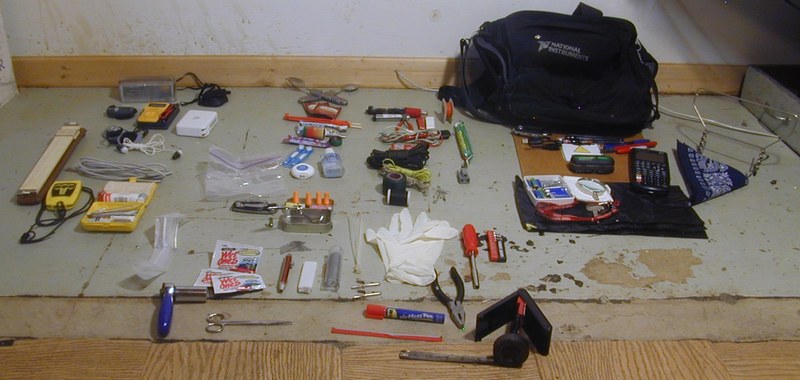
This writeup was inspired by a friend complaining he had to walk his bike home after one of the pedals fell off. The nut that held it to the gear wiggled it's way out and was lost halfway home from his work. I examined the bike, and concluded that my laptop case contained 3 different methods of providing a temporary or a near permanent repair. Duct tape, for the "may get you home, may not" jerry rig fix, ShapeLock for the "should hold forever but can be removed", and JB Stick for "It'll take fire to remove this sucker". There's something satisfying with knowing that I'm prepared for most of life's little disasters, and that I can walk through my life fixing things for other people. My total load is a hair under 30 pounds, and about the size of two stacked textbooks, and while I can't say it's saved my life, it's made it far simpler at times. I can't recommend you go as overboard as I, but next time something breaks on you, think "What could I have carried that would have fixed this?", and toss that item into your briefcase, purse or glovebox. Start with my 4 favorites (trash bag, duct tape, rope/string and scissors) and add whatever your specialty is.
Who, after all, regrets being too prepared?
If you wish to comment on my gear, send me an email at p@ohbah.com.
Return to index. All works on this page is copyright 2009 Patrick Tait. Some rights reserved: 